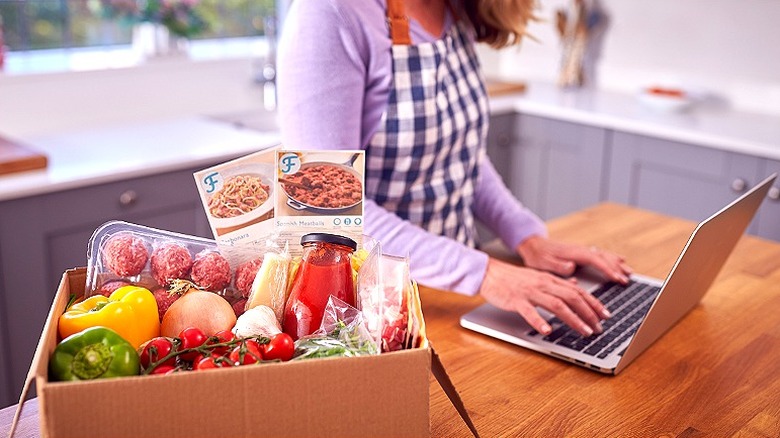Meal Kits Vs. Grocery Shopping: Which Is Cheaper?
Not everyone loves to work in the kitchen. As wonderful as a home-cooked meal can be, the expense, the preparation, and the effort involved isn't worth it for some, particularly at the end of a long day. And during a once-in-a-lifetime crisis like the COVID-19 pandemic, getting fresh groceries can also be hazardous. Small wonder, then, that the pandemic drove a boom in the home-delivered meal kit business. Subscription-based companies like HelloFresh and Blue Apron did record business in 2020.
Of course, now that the pandemic has passed, it's safe to shop again, and meal kit companies have seen a decline in profits. But with customers still feeling the sting of high grocery prices as of November 2024, might meal kits be the more affordable choice? CBS News ran a trial, comparing the price of a meal kit for pork tenderloin with spicy aioli with the cost of getting all the ingredients to make the meal from scratch. At a subscription tier that delivered four meals for two per week, Green Chef's tenderloin cost $13. Shopping for the individual ingredients at Walmart came to $52.
It was a significant difference, to be sure, but it was one specific meal and two specific companies. Whether or not you'll save money on kits over home cooking can be a complicated question, with the answer shifting by the meal and the outlet.
Meal kit prices vary by company and plan
Many meal kit companies operate on a subscription basis, with varying degrees of customization. Home Chef is particularly flexible, allowing customers to customize ingredients, portions, and how many meals they receive each week. But whether you have such options or not, you pay a price based on your plan, which can then be broken down by portion to compare to what a trip to the grocery store would run you for the same ingredients.
Leaving out shipping costs, Money Digest's review of Home Chef found a standard meal came to $9.99 per portion, with upcharges for some ingredients. This puts Home Chef's meal kits down as significantly more expensive than a home-cooked meal; the cost of ingredients for home cooking averages out to $4.31, according to AI food technology company wellio (via Forbes). With this said, Home Chef's per-portion price drops the more servings you order, and in 2023, the company rolled out its family menu (for four) that averages $6.99 to $8.99 per person. While Home Chef's prices are considered average overall for meal kits today, it should be noted there's notable variance between plans with kit subscriptions.
CNET, meanwhile, found that plans offered by Home Chef competitor EveryPlate ranged from $5 to $8, with the average being $7.48 per serving for a plan meant for two. That still puts the kit over the cost of groceries, but for cheaper plans, the difference can be as little as a dollar. And while meal kits have been affected by inflation just like groceries, subscription prices haven't grown as dramatically.
Supermarkets now carry meal kits, too
It might be the case, on average, that groceries still cost less than meal kits by at least a slight amount. But there's not necessarily a hard dividing line between groceries and meal kits. After seeing the boom in meal kit sales during the pandemic, particularly with younger demographics, chains like Kroger decided that it would be worth getting into the game. In Kroger's case (per The Washington Post), the supermarket absorbed Home Chef.
Kroger isn't the only one to make such a purchase. A number of supermarkets now offer meal kits in their deli and freezer sections, either through companies owned by the same parent corporation or through licensing deals. Besides letting customers buy them in stores, grocery chains also act as a delivery service, running kits as well as grocery orders out to customers' homes. Incorporating kits in this way is one way for chains to bend rather than break to the pressures subscription services place on their business model — not only cost, but convenience.


